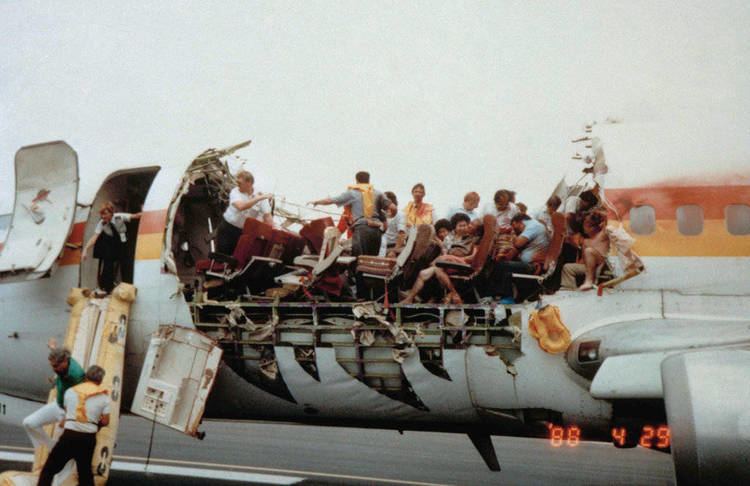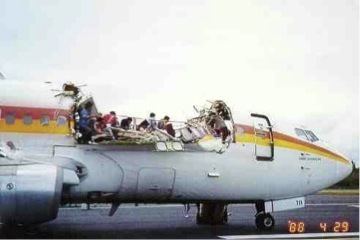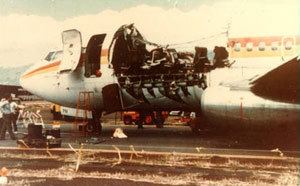Crew 5 Survivors 94 Date 28 April 1988 | Passengers 90 Injuries (nonfatal) 65 Location Hawaii, United States Location Kahului | |
 | ||
Summary Explosive decompression caused by metal fatigue, maintenance error Destination Honolulu International Airport Similar Southern Airways Flight 242, Air France Flight 296, Alaska Airlines Flight 261, United Airlines Flight 811, Northwest Airlines Flight 255 | ||
Aloha Airlines Flight 243 (AQ 243, AAH 243) was a scheduled Aloha Airlines flight between Hilo and Honolulu in Hawaii. On April 28, 1988, a Boeing 737-297 serving the flight suffered extensive damage after an explosive decompression in flight, but was able to land safely at Kahului Airport on Maui. There was one fatality, flight attendant Clarabelle "C.B." Lansing, who was ejected from the airplane. Another 65 passengers and crew were injured. The safe landing of the aircraft despite the substantial damage inflicted by the decompression established Aloha Airlines Flight 243 as a significant event in the history of aviation, with far-reaching effects on aviation safety policies and procedures.
Contents

Aircraft

The airframe, the 152nd Boeing 737 built, named Queen Liliuokalani after Lili'uokalani, with registration N73711, was built in 1969 and delivered to Aloha Airlines as a brand-new aircraft. While the airframe had only accumulated 35,496 flight hours prior to the accident, those hours were over 89,680 flight cycles (a flight cycle is defined as a takeoff and a landing), owing to its use on short flights.
Details

The flight departed Hilo at 13:25 HST on April 28, 1988 with five crew members and 90 passengers, bound for Honolulu. No unusual occurrences were noticed during the pre-departure inspection of the aircraft. The aircraft had previously completed 3 round-trip flights from Honolulu to Hilo, Maui, and Kauai that day, all uneventful. Meteorological conditions were checked but no advisories for weather phenomena occurred along the air route, per Airman’s meteorological information (AIRMET) or significant meteorological information (SIGMET). The captain was 44-year-old Robert Schornstheimer. He was an experienced pilot with 8,500 flight hours; 6,700 of those were in Boeing 737s. The first officer was 36-year-old Madeline "Mimi" Tompkins. She also had significant experience flying 737s, having logged 3,500 of her total 8,000 flight hours in them.

No unusual occurrences were reported during the take-off and ascent. Around 13:48, as the aircraft reached its normal flight altitude of 24,000 feet (7,300 m) about 23 nautical miles (43 km) south-southeast of Kahului, Maui, a small section on the left side of the roof ruptured with a "whooshing" sound. The captain felt the aircraft roll left and right, and the controls went loose. The first officer noticed pieces of grey insulation floating over the cabin. The door to the cockpit was gone, and the captain saw "blue sky where the first-class ceiling had been." The resulting explosive decompression tore off a large section of the roof, consisting of the entire top half of the aircraft skin extending from just behind the cockpit to the fore-wing area, a length of about 18.5 feet (5.6 m).

Fifty-eight-year-old Flight Attendant Clarabelle Lansing was the only fatality; she was thrown out of the plane while standing near the fifth row seats. Her body was never found. She was a veteran flight attendant of 37 years at the time of the accident. Eight others suffered serious injuries. All the passengers were in their seats and belted during depressurization.

First officer Tompkins was flying the aircraft at the time of the incident. After discovering the damage, the captain took over and steered the aircraft to the closest airport, on Maui island. Thirteen minutes later, the crew performed an emergency landing on Kahului Airport's Runway 2. Upon landing, the crew deployed the aircraft's emergency evacuation slides and evacuated passengers from the aircraft quickly. Tompkins assisted passengers down the evacuation slide. In all, 65 people were reported injured, eight seriously. At the time, Maui had no plan for a disaster of this type. The injured were taken to the hospital by the tour vans from Akamai Tours (now defunct) driven by office personnel and mechanics, since the island only had a couple of ambulances. Air traffic control radioed Akamai and requested as many of their 15-passenger vans as they could spare to go to the airport (three miles away) to transport the injured. Two of the Akamai drivers were former medics and established a triage on the runway. The aircraft was a write-off.
Aftermath
As a result of the accident, the airplane was determined to be damaged beyond repair and was dismantled on-site. Additional damage to the airplane included damaged and dented horizontal stabilizers, both of which were struck by flying debris. Some of the metal debris also struck the aircraft's tail fin, causing some slight damage. The leading edges of both wings and both engine cowlings were also damaged and dented.
Neither Lansing's body nor the piece of the fuselage that was blown off the aircraft were ever found. Investigation by the United States National Transportation Safety Board (NTSB) concluded that the accident was caused by metal fatigue exacerbated by crevice corrosion. The aircraft was 19 years old and operated in a coastal environment, with exposure to salt and humidity.
During an interview, passenger Gayle Yamamoto told investigators that she noticed a crack in the fuselage upon boarding the aircraft prior to the ill-fated flight, but did not notify anyone.
Construction
For the aircraft production number 292 (B-737) and after (this aircraft was production line number 152), an additional outer layer of skin or doubler sheet at the lap joint of the fuselage was added. In the construction of this aircraft this doubler sheet was not used in addition to other details of the bonding of the parts. In the case of production line 292 and after, this doubler sheet gave an additional thickness of 0.91 mm (0.036 in) at the lap joint. In airplane line number 291 and before, cold bonding had been utilized, with fasteners used to maintain surface contact in the joint, allowing bonding adhesive to transfer load within the joint. This cold bonded joint used an epoxy-impregnated woven scrim cloth to join the edges of 0.9 mm thick skin panels. These epoxy cloths were reactive at room temperature, so they were stored at dry ice temperatures until used in manufacture. The bond cured at room temperature after assembly. The cold bonding process reduced the overall weight and manufacturing cost. Fuselage hoop loads (circumferential loads within the skins due to pressurization of the cabin) were intended to be transferred through the bonded joint, rather than through the rivets, allowing the use of lighter, thinner fuselage skin panels with no degradation in fatigue life.
The additional outer layer construction improved the joint by:
Conclusion
The investigation determined that the quality of inspection and maintenance programs were deficient. Also, the fuselage failure initiated in the lap joint along S-10L; the failure mechanism was a result of multiple site fatigue cracking of the skin adjacent to rivet holes along the lap joint upper rivet row and tear strap disbond which negated the fail-safe characteristics of the fuselage. Finally, the fatigue cracking initiated from the knife edge associated with the countersunk lap joint rivet holes; the knife edge concentrated stresses that were transferred through the rivets because of lap joint disbonding.
Under current FAA regulations for the Boeing 737 (line number 291 and prior) established in the 2010s, this airframe would have had to be permanently withdrawn from service after 34,000 flight cycles or 34,000 hours, whichever came first. The nearly 90,000 flight cycles exceeded the "lifetime of validity" of the 737-100/200 under the new rules.
The NTSB concluded in its final report on the accident:
The National Transportation Safety Board determines that the probable cause of this accident was the failure of the Aloha Airlines maintenance program to detect the presence of significant disbonding and fatigue damage which ultimately led to failure of the lap joint at S-10L and the separation of the fuselage upper lobe. Contributing to the accident were the failure of Aloha Airlines management to supervise properly its maintenance force; the failure of the FAA to require Airworthiness Directive 87-21-08 inspection of all the lap joints proposed by Boeing Alert Service Bulletin SB 737-53A1039; and the lack of a complete terminating action (neither generated by Boeing nor required by the FAA) after the discovery of early production difficulties in the B-737 cold bond lap joint which resulted in low bond durability, corrosion, and premature fatigue cracking.
One board member dissented, arguing that the fatigue cracking was clearly the probable cause, but that Aloha Airlines maintenance should not be singled out because failures by the FAA, Boeing, and Aloha Airlines Maintenance each were contributing factors to the disaster.
Alternative explanation
Pressure vessel engineer Matt Austin has proposed an additional hypothesis to explain the scale of the damage to Flight 243. This explanation postulates that initially the fuselage failed as intended and opened a ten-inch square vent. As the cabin air escaped at over 700 mph, flight attendant C.B. Lansing became wedged in the vent instead of being immediately thrown clear of the aircraft. The blockage would have immediately created a pressure spike in the escaping air, producing a fluid hammer (or "water hammer") effect, which tore the jet apart. The NTSB recognizes this hypothesis, but the board does not share the conclusion. Former NTSB investigator Brian Richardson, who led the NTSB study of Flight 243, believes the fluid hammer explanation deserves further study.
Dramatizations
The story of the disaster was featured in a third-season episode of the Discovery Channel Canada / National Geographic series Mayday (broadcast in some countries as Air Emergency and Air Crash Investigation). The episode, titled Hanging By a Thread, explores the events surrounding the crash and its investigation, including interviews with NTSB investigators and survivors.
The story was also the subject of the 1990 made-for-television movie Miracle Landing.
